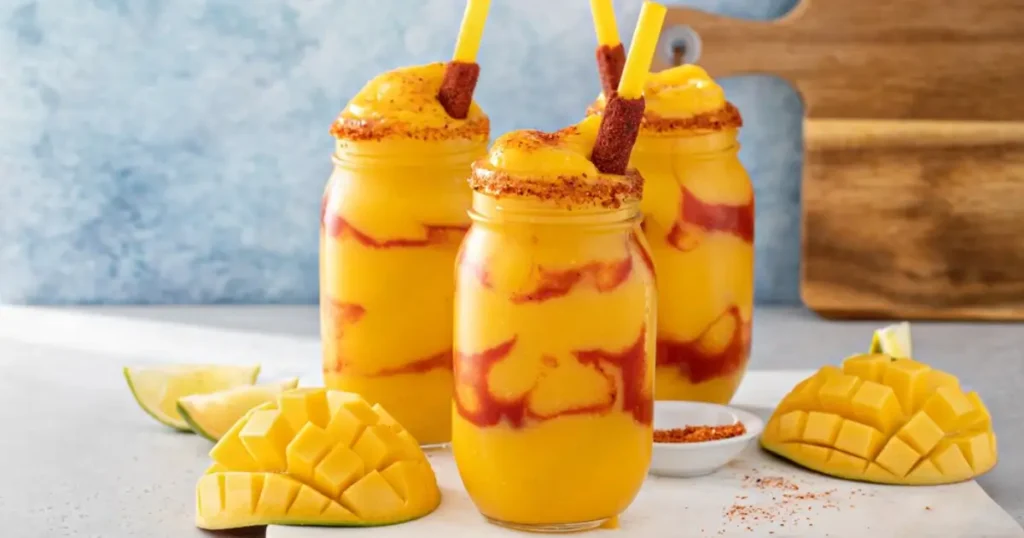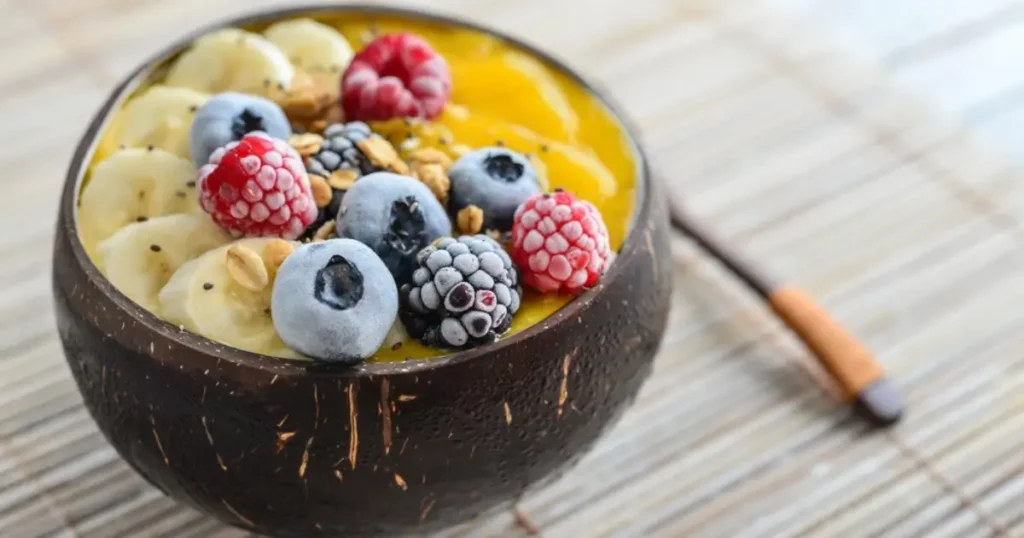Table of Contents
Introduction
Tropical smoothies are a delicious and refreshing way to enjoy a blend of fruits, but have you ever wondered about tropical smoothie calories? While these drinks are often seen as a healthy choice, the reality is that many tropical smoothies contain hidden sugars and high-calorie ingredients that can add up quickly. If you’re trying to maintain a balanced diet or lose weight, understanding tropical smoothie calories is essential.
Many store-bought smoothies, including those from popular chains, can have tropical smoothie calories ranging anywhere from 300 to over 600 calories per serving. This is often due to added fruit juices, sweeteners, and full-fat dairy products that increase the calorie count without providing much nutritional benefit. Even homemade versions can be high in tropical smoothie calories if not prepared with the right ingredients.
The good news is that with a few simple swaps, you can significantly reduce tropical smoothie calories while still enjoying a delicious and nutrient-packed drink. By making smarter choices, such as opting for low-calorie liquid bases, natural sweeteners, protein-rich ingredients, and controlled fruit portions, you can create a healthier version without sacrificing flavor.
In this guide, we’ll explore four easy ingredient swaps that will help lower tropical smoothie calories while keeping your smoothies tasty, filling, and nutritious. Whether you’re looking to lose weight, improve your diet, or simply enjoy a guilt-free smoothie, these tips will help you make the best choices. Let’s dive in!
Understanding Tropical Smoothie Calories

When it comes to enjoying a refreshing smoothie, many people don’t realize how high tropical smoothie calories can be. While tropical smoothies are often marketed as healthy, they can contain more calories and sugar than expected. Ingredients like fruit juices, full-fat dairy, and sweetened yogurt contribute to higher tropical smoothie calories, making it important to check tropical smoothie nutrition facts before consuming them regularly.
One of the biggest factors affecting tropical smoothie calories is the type of ingredients used. A mango pineapple smoothie made with fruit juice and added sugar can have significantly more calories than one made with unsweetened almond milk and fresh fruit. Similarly, a mango strawberry smoothie with full-fat yogurt and honey can add unnecessary sugars, increasing the overall tropical smoothie calories.
Checking tropical smoothie nutrition facts can help you make better choices when ordering or making smoothies at home. Many store-bought tropical smoothies contain hidden sugars that increase tropical smoothie calories without providing much nutritional benefit. Even homemade versions can be calorie-dense if they include excessive amounts of high-sugar fruits or calorie-rich liquids.
Understanding tropical smoothie calories is essential for maintaining a balanced diet. By being mindful of tropical smoothie nutrition facts, you can enjoy a mango pineapple smoothie or mango strawberry smoothie without worrying about excessive calorie intake. Making simple ingredient swaps and paying attention to portion sizes will help you keep tropical smoothie calories under control while still enjoying their delicious flavors.
Swap #1 – Use Low-Calorie Liquid Bases
One of the easiest ways to reduce tropical smoothie calories is by choosing the right liquid base. Many store-bought and homemade smoothies use high-calorie liquids like fruit juice, whole milk, or sweetened yogurt, which significantly increase tropical smoothie nutrition facts without adding much nutritional value. By swapping these out for lower-calorie alternatives, you can enjoy a delicious mango strawberry smoothie or mango pineapple smoothie without the extra calories.
A common mistake people make is using fruit juice as a base, thinking it’s a healthy choice. However, fruit juice is high in natural sugars, which increase tropical smoothie calories and lead to blood sugar spikes. Instead, opt for unsweetened almond milk, coconut water, or plain water. These options provide hydration and flavor while keeping tropical smoothie calories lower.
If you enjoy a creamy texture, Greek yogurt is a great alternative to full-fat milk or sweetened yogurt. Greek yogurt adds protein and probiotics while reducing tropical smoothie calories compared to traditional dairy products. For an even lighter option, unsweetened oat milk or cashew milk can enhance the taste of a mango pineapple smoothie without excess calories.
By making this simple swap, you can significantly cut down on tropical smoothie calories while still enjoying a refreshing and satisfying drink. Whether you’re blending a mango strawberry smoothie or experimenting with other tropical flavors, choosing the right liquid base is a crucial step toward a healthier smoothie.
Swap #2 – Replace Sugary Additives with Natural Sweeteners

One of the biggest contributors to high tropical smoothie calories is the addition of processed sugars and sweeteners. Many store-bought and homemade smoothies contain honey, agave syrup, or flavored yogurt, all of which increase tropical smoothie nutrition facts without adding much nutritional value. If you want to enjoy a mango pineapple smoothie or a mango strawberry smoothie without excess sugar, switching to natural sweeteners is a simple and effective solution.
Fruits naturally contain sugar, so adding extra sweeteners isn’t always necessary. Instead of honey or syrup, rely on naturally sweet fruits like bananas, ripe mangoes, or pineapples to enhance the flavor while keeping tropical smoothie calories in check. A mango strawberry smoothie already has natural sweetness, making additional sugar unnecessary.
Another great alternative is using dates as a natural sweetener. Dates provide fiber and essential nutrients while adding a caramel-like sweetness to your smoothie. Unlike refined sugar, dates contribute to better digestion and help regulate blood sugar levels, making them a healthier choice in tropical smoothie nutrition facts.
If you want to enhance sweetness without adding sugar, try spices like cinnamon or vanilla extract. These natural flavor boosters can make a mango pineapple smoothie taste richer and more satisfying without increasing tropical smoothie calories. By replacing artificial and processed sweeteners with these natural alternatives, you can create a healthier smoothie that’s just as delicious.
Swap #3 – Add More Protein and Fiber for Satiety
Another effective way to reduce tropical smoothie calories while making your drink more filling is by increasing its protein and fiber content. Many traditional smoothies are loaded with fruit and fruit juice, which can cause a rapid spike in blood sugar. While fruits like mangoes and pineapples add natural sweetness, they can also raise tropical smoothie calories if used in excess. By incorporating protein and fiber-rich ingredients, you can create a more balanced mango strawberry smoothie or mango pineapple smoothie that keeps you full for longer.
Protein is essential for muscle repair and sustained energy, making it a great addition to smoothies. Instead of relying on full-fat dairy or sweetened yogurts that add unnecessary tropical smoothie calories, opt for Greek yogurt, unsweetened protein powder, or plant-based protein sources like chia seeds and hemp seeds. A scoop of protein powder in a mango pineapple smoothie can add creaminess and nutrition without extra sugar.
Fiber also plays a crucial role in keeping smoothies satisfying without excess calories. Leafy greens like spinach or kale blend well into tropical smoothies without altering the taste but help lower the overall glycemic impact. Adding chia seeds, flaxseeds, or oats can further boost fiber content while improving tropical smoothie nutrition facts.
Balancing protein and fiber with fruit ensures that a mango strawberry smoothie is not just tasty but also nutritious and sustaining. By making this simple swap, you can enjoy lower tropical smoothie calories while getting more essential nutrients in every sip.
Swap #4 – Control Your Fruit Portions Wisely

While fruits are a key ingredient in tropical smoothies, using too much can significantly increase tropical smoothie calories. Many people assume that because fruit is healthy, adding more will make a smoothie better. However, excessive fruit can lead to high sugar content and impact tropical smoothie nutrition facts. If you love a mango strawberry smoothie or a mango pineapple smoothie, being mindful of portion sizes is essential for keeping your drink balanced and nutritious.
One common mistake is adding multiple high-sugar fruits like bananas, mangoes, and pineapples in large amounts. While these fruits provide essential vitamins, they also raise tropical smoothie calories. A better approach is to mix lower-calorie fruits, such as berries, watermelon, or citrus, with a controlled portion of tropical fruits. This ensures you still get the tropical flavors without unnecessary sugar spikes.
Another great strategy is to follow the 40-30-30 smoothie rule—40% vegetables (like spinach or kale), 30% fruit, and 30% protein or healthy fats. This balance improves tropical smoothie nutrition facts by providing fiber, vitamins, and protein while keeping tropical smoothie calories under control. For example, a mango pineapple smoothie with spinach and Greek yogurt will be more nutritious and filling than one made with just fruit and juice.
Using frozen fruit instead of fresh can also help with portion control. Pre-measured frozen mangoes or strawberries ensure that you’re not overloading on fruit while maintaining the smoothie’s natural sweetness. By being mindful of portions and choosing the right fruit combinations, you can enjoy a delicious and nutritious smoothie with fewer tropical smoothie calories.
Conclusion
Reducing tropical smoothie calories doesn’t mean sacrificing flavor. By making a few simple swaps, you can enjoy a delicious and nutritious smoothie without excess sugar or calories. Choosing low-calorie liquid bases, replacing processed sugars with natural sweeteners, adding protein and fiber for satiety, and controlling fruit portions all contribute to better tropical smoothie nutrition facts while keeping your smoothies just as satisfying.
Whether you’re making a mango strawberry smoothie or a mango pineapple smoothie, these small adjustments can have a big impact on your overall health. Instead of relying on store-bought smoothies with hidden sugars, try making your own with balanced ingredients that support your fitness and wellness goals.
By following these easy swaps, you can take control of tropical smoothie calories and enjoy your favorite tropical flavors guilt-free. Start experimenting with different ingredient combinations and see how simple it is to create a healthier version of your favorite smoothie today!




